This story features photographs by:
Chris Davis
Bryan Derballa
Nick Fancher
Peter Murphy
Richard Boll
Alyssa Schukar
Stephen Simpson
Stacy Skinner
Kate Warren
These rising Kenyon achievers are proof that the future is in good hands.
Story by Elizabeth Weinstein, David Hoyt ’14, Dennis Fiely, Dan Laskin and Sue Angell
Who’s going to give the future its breakthroughs and discoveries, its page-turners and show-stoppers, its innovations in teaching, policy, media and tech? Meet a young alumni from every graduating class between 2007 and 2016 worthy of your attention.
Only a few years ago, they were marching down Middle Path toward that big Commencement stage. They’re just beginning to find a vocational focus — in some cases, while making their way through graduate school. Fledglings? Maybe. But take note. In the lab and in performance, in schools and in the “field,” teaching, tinkering, venturing out and buckling down, they’re already making a remarkable difference.
The Bulletin would like to introduce you to a rising generation of Kenyon achievers. If you’re already familiar with names like Nick Petricca ’09 (from the band Walk the Moon) and young adult author Rioghnach Robinson ’16, we think you’ll be impressed by this bunch of up-and-comers — their talent, their drive, their creativity, their prospects. And we suspect you’ll agree that, with Kenyon alumni like these in the vanguard, the future is in pretty good hands.
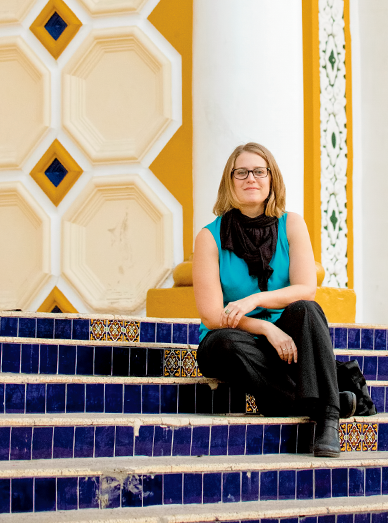
Hometown: King of Prussia, Pennsylvania | Resides in: Tijuana, Mexico | Majored in: International studies | Job title: Foreign Service officer, U.S. Department of State
As a U.S. diplomat in the Foreign Service, Meg Ahearn ’07 functions as a public face for the U.S. around the world. She has served in Abuja, Nigeria, and Tijuana, Mexico, and soon will be posted stateside in Washington, D.C. While Ahearn became fluent in Spanish and studied Latin America during her time at Kenyon, she’ll likely find herself representing American interests all over the world during the course of her career.
Favorite post: “None of us really have dream locations, because we move around very frequently,” she said. “Everything is very fluid, and that’s something that Foreign Service officers embrace.” That said, Ahearn especially enjoyed a temporary posting at the U.S. Mission to the United Nations in New York City. “That exposed me to the multilateral diplomacy world, and I’m very much hoping to work in that capacity again.”
Why she chose this career: When Ahearn was very young, her grandmother was involved in a fatal car accident in Italy. “My mother got a call in the middle of the night and had to fly to Parma,” she said. “And she had the most wonderful things to say about what the consulate staff and the Foreign Service officer there did to help her and support her.” Remembering that experience, Ahearn chose to focus on consular work, meaning she assists Americans abroad who run into trouble, and helps facilitate safe travel and international commerce by adjudicating visas for foreign citizens hoping to travel to the U.S. “I wanted to be able to directly give back in that way that was so important for my family.”
The Meg Ahearn Guide to Tijuana: “Tijuana is in the middle of a food and cultural revolution; it’s a great place to visit right now. There are amazing craft breweries, food trucks and restaurants ranging from the best meal you’ve ever had for $5 to a meal that is cooked by a world-class chef,” she said. “The other thing I would recommend here is the wine country. It’s called the Valle de Guadalupe, and it’s considered one of these emerging wine areas — the new Napa Valley.”
Awkward diplomatic moment: While on temporary assignment at the U.S. Embassy in Mexico City, Ahearn processed a visa for a Mexican actor. Seeing on his application that the actor had been in a film she had seen recently, but not recognizing him, she asked what role he had played. Turns out, he was the star. “The character in the movie had a beard, and the real-life person did not,” Ahearn explained.
Advice for the budding diplomat: “There’s no straight line that leads you to this kind of work. I think that’s something people sometimes forget, and they sometimes get discouraged after taking the foreign service exam a few times. That’s very normal, and there’s no specific set of criteria you have to have to get in. Actually, the minimum level of education is a high school diploma. And I came in without a master’s degree.
Get some real-life work experience, get your hands dirty, push yourself as much as you can."
But I would say, get some real-life work experience, get your hands dirty, and push yourself as much as you can in the career and the job that you’re in now, or your schoolwork if you’re still a student. And always take opportunities and try new things when they are available to you, because that’s what’s going to best prepare you for a career in the foreign service.”
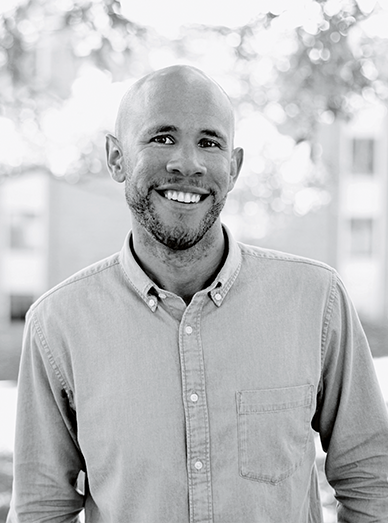
Hometown: Los Angeles | Resides in: Los Angeles | Majored in: Psychology | Advanced degree: Master's in social work from Columbia University | Job title: Clinical social worker and owner of Grab The Wheel Kids: Anger Management and Social Skills
Any parent or educator will tell you that anger problems profoundly can hinder a child’s ability to thrive both in and out of the classroom. Enter Bryan Anderson ’08, who is carving a niche for himself in the field of social work by providing young children with the proper tools to better understand and manage their emotions. Grab The Wheel Kids — a Los Angeles-based therapy practice and consulting firm that he recently founded — offers anger management and social skills coaching to children (including children on the autism spectrum) and training opportunities to parents, teachers and therapists, based on a finely honed curriculum he developed. Anderson literally has written the book on this topic — “Grab the Wheel: Helping Young Children Manage Explosive Anger” — which will be published this spring.
All in the family: For Anderson, psychology is the family business. His mother, Nancy, is an elementary school psychologist and his father, George, developed a curriculum of pioneering anger management techniques that is widely used within the mental health field.
Grabbing the wheel: With the support of his mentor and former supervisor Dr. Stephanny Freeman, who co-directs the Early Childhood Partial Hospitalization Program at UCLA, Bryan adapted his dad’s curriculum to the needs of small children. The resulting book, “Grab the Wheel,” (co-authored with Freeman, Dr. Tanya Paparella and Kelly Ferraro), helps children learn to cope with difficult situations.
The “Good Choice Wheel”: At the core of Anderson’s book is a “Good Choice Wheel” that lays out the four most important coping skills that young children need — strong words, listening, saying how they feel and trying something different. Each skill is represented by a character, and each character reinforces a particular set of behavioral skills.
Makeshift impressionist: He coaxes laughs from kids by performing impressions. His go-to impression: Barack Obama.
In his own words: “People are so open at Kenyon. They are so open to each other. I think that the way that people are included at Kenyon really gave me the ability to go with the flow and get along with anybody, no matter how different they are from me, where they might come from, and what kind of experiences they have had. Kenyon opened my eyes up to the rest of the world.”
Find Bryan Anderson at: grabthewheelkids.com | on Twitter: @GoodChoiceWheel | on Instagram: @grabthewheelkids | on Facebook: facebook.com/GrabTheWheel
— Sue Angell and Elizabeth Weinstein
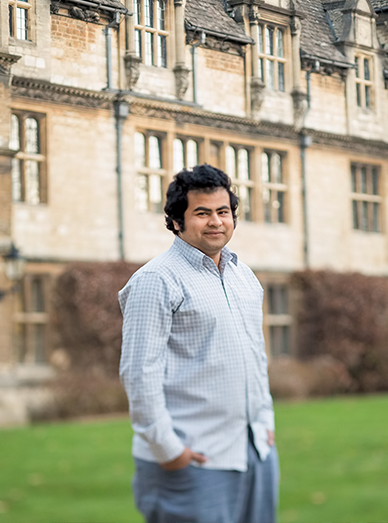
Hometown: Biratnagar, Nepal | Resides in: Oxford, England | Majored in: International studies and political science | Advanced degree: Master's and doctorate in international development from the University of Oxford | Job title: Consultant, Oxford Policy Management; founder and executive director, Samaanta Foundation
For Shrochis Karki ’09, the personal is political. His parents made sacrifices to afford his schooling in Nepal, and now he spends his time working to improve education in low- and middle-income countries. He also gives back to his native Nepal as founder and executive director of the Samaanta Foundation, which provides higher education opportunities to students from rural areas.
Globetrotting: In his work for Oxford Policy Management, an international development firm dedicated to reducing social and economic disadvantages around the world, Karki spends a significant amount of time each year in other countries, helping to research, design, implement and evaluate education projects. This year, he has worked in Pakistan, Nepal and Tanzania, and he recently returned from the Philippines, where he is evaluating a UNICEF program on education. Wherever he goes, he tries to stay long enough to get to know the people and their culture. “There is a way to do this work with minimal travel, but I believe it is important (to be in the field) to get a full understanding of the issues at the local level,” he said.
Paying it forward: Scholarships supported Karki at Kenyon and as a graduate student at the University of Oxford. “I have other friends just as fortunate with similar stories about how the support we received for our education helped us overcome impediments to our success. Together, we want to help students in Nepal continue their education in the way we were helped. We set up the Samaanta Foundation (Samaanta means equality in Nepali) five years ago with six fellows. We have supported 32 fellows already, including 25 active fellows right now,” he said.
Experimenting for Success: “We started the foundation as an experiment in some ways, as we didn’t know what would happen. The national average pass rate in higher education in Nepal is less than 40 percent, but our fellows have maintained a 100 percent percent pass rate so far. They are succeeding both academically and socially, so the experiment is thankfully paying off.”
Vision quest: Karki always hoped that a Samaanta Foundation student would land at Kenyon. His dream may come true sooner than expected, when one of his fellows (scholarship recipients) is expected to apply for admission. “The fact that she is able to apply to Kenyon is an indication of our success for us,” he said.
Responsible leadership: In the aftermath of the 2015 Nepal earthquake, Karki worked to reach communities not prioritized immediately by mainstream relief efforts. Through personal and institutional networks, he mobilized funds to assist grassroots organizations, including importing goods directly from India, to reach vulnerable groups rapidly. Karki supported Samaanta’s partners to reach more than 20,000 families with food, medical supplies, clothing and shelter. Remarkably, Samaanta partners were first responders in more than 90 percent of their target communities in the hardest hit districts of Nepal.
Achieving balance: “I play cricket for a club team in England and enjoy watching a lot of sports, like soccer and tennis. I like to think that I have a good sense of humor as well. I’m able to joke around to balance out the serious nature of my work.”
Find Shrochis Karki on Facebook: @SamaantaFoundation

Hometown: Knoxville, Tennessee | Resides in: New York City | Majored in: English and studio art | Job title: Photography editor, Vanity Fair
As a college student, Rachel D. Williams ’10 dreamed of working at Vanity Fair magazine. Getting there, she acknowledged, has been the result of equal parts hard work and serendipity. She completed internships throughout her Kenyon career at Art + Commerce (IMG), Harper’s Bazaar and Mercedes-Benz Fashion Week. Then, during her senior year, “I was at a dinner with some trustees and this really nice gentleman was sitting next to me,” she said. “After discussing my past internships, he asked me, ‘If you could work at any magazine, what would it be?’ I said ‘Vanity Fair’ without blinking. He said, ‘Graydon (Carter, Vanity Fair’s longtime editor) is a good friend of mine. I’d be happy to put you in touch.’” This informal dinner conversation led to an interview with Vanity Fair’s managing editor Chris Garrett — which led, eventually, to a job offer in the photo department. She has worked on shoots with Caitlyn Jenner, Patti Smith and countless other celebrities and luminaries.
A typical workday: “You’re basically doing a million things at once. You’re trying to find a location, book the catering and cars, confirm dates, look for hair and makeup stylists and work with the wardrobe stylist to help get clothing for the shoot. You’re connecting dots. I love it because I like to help creative projects evolve and grow.”
On working with Annie Leibovitz and her long-time senior producer Kathryn MacLeod: “They really dream the impossible and then we try to figure out how to make it happen. It’s such an exciting puzzle and a challenge. It asks a lot of you, but when you are in the moment and then you see the beautiful photographs afterwards, it always seems worth it. The juice is worth the squeeze.”
Fun fact: The day after attending her five-year reunion at Kenyon in 2015, Williams flew to Havana, where she worked with Kathryn MacLeod on a cover story photo shoot with pop star Rihanna. It was an unusual shoot because U.S. credit cards and cell phones didn’t work there. “It forced us to be very present,” Williams said. “We were all using burner phones and I was responsible for connecting Rihanna’s team with the photo team.”
All in the details: “Entry-level jobs are just as much about what you see as they are about what you do. When I started, I was doing coffee runs, I was down on my hands and knees picking up garbage (leftover from catering). Don’t expect it to be glamorous. Don’t be above the small things. I think sometimes just completing what may seem to be the simplest of tasks — if you can do it quietly and with sharp attention to detail — it will set you apart.”
Find Rachel DeLoache Williams at: vanityfair.com | on Instagram: @rdwilliams | on Twitter: @racheldeloache
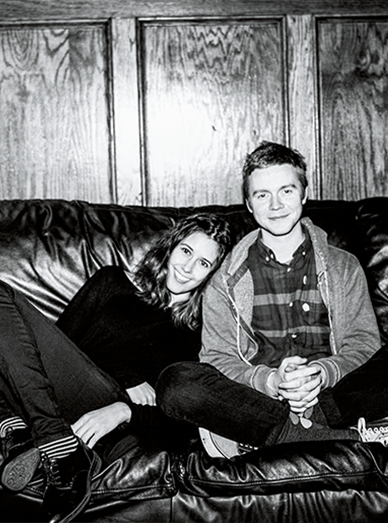
Hometowns: Hall is from Montclair, New Jersey; Plunkett is from Williamstown, Massachusetts | Reside in: Montclair, New Jersey (Hall) and Bloomfield, New Jersey (Plunkett) | Majored in: Hall majored in English; Plunkett majored in music, specializing in classical singing and composition | Job title: Musicians. Both play in Pinegrove, which was started by Hall and his longtime friend Zack Levine; Plunkett started another band in 2012, called Half Waif.
Pinegrove’s debut full-length album, “Cardinal,” has picked up a steady stream of accolades since it was released by Run for Cover Records last year. The band was featured on “CBS This Morning” and in an album review, Spin magazine called “Cardinal” a record “lovingly crafted and intimately written, full of sounds, observations, and emotional realizations that you didn’t know you wanted in 2016, but, in fact, needed desperately.” The band also appeared on numerous 2016 year-end “best of” music lists and performed a “Tiny Desk Concert” on NPR. Doubling up on the buzz, Nandi Rose Plunkett ’11 was the subject of a lengthy Village Voice profile last year. Half Waif’s new EP, “form/a,” was released in February and the band, fittingly, has toured with Pinegrove.
On categorizing their music: Evan Stephens Hall ’11 describes Pinegrove’s sound as “language arts rock” (a nod to the narrative nature of his songs), “post-country” and “cerebral Americana.” Nandi Rose Plunkett ’11 describes Half Waif as “mood-pop ring,” or “pop music with a more experimental take.”
Sounds like: Pinegrove: Julian Baker, Hold Steady, Arcade Fire, Wilco, Josh Ritter. Half Waif: Lucy Dacus, St. Vincent, Frankie Cosmos, Julia Holter, Waxahatchee.
What’s in a name: Pinegrove takes its name from a man-made forest of pine trees in Gambier, but Hall prefers not to name the exact location in print. “It’s better when Pinegrove fans at Kenyon discover it for themselves,” he said. “I remember the first time that I accidentally stumbled upon it. It was just the most magical moment, and part of that was the surprise. So I want to retain that for other seekers and explorers.”
It was just the most magical moment, and part of that was the surprise. So I want to retain that for other seekers and explorers."
Humble and harmonious beginnings: The seeds for Pinegrove were planted in room 109 of Mather Residence Hall — Hall’s first-year room — where he spent much of his time reading and writing songs. He met Plunkett at a songwriters’ circle and the musical chemistry was apparent right away. “There is just something about singing with Evan,” said Plunkett, who also sang with the Owl Creeks and Colla Voce. “Our voices are very different in a lot of ways but the timbres are very similar, so sometimes when we record, we’ll listen back to the recording and you can’t tell whose voice it is, which is astounding. It’s a really deep connection that we both felt immediately.”
The realities of touring: “It was a stunning realization to find that it was not vacation. It was a job,” Hall said of a recent tour that took Pinegrove all over Europe. “The drives are pretty and the cities are gorgeous, but we go in for sound check, we eat a meal, we play a show and then we go to the hotel. And then we drive for hours the next day to our next stop. It goes on just like that.”
The rock ’n’ roll life: During the summer, the members of Pinegrove and Half Waif quit their day jobs (Plunkett worked for a music nonprofit, Hall worked part-time at a bookstore) to commit themselves full-time to music. And that’s not the only stabilizing thing they gave up in pursuit of their dream. “(Bandmate Zack Levine) and I were living in Brooklyn and our lease was running out,” Plunkett said. “We were like, ‘We are going to be on the road so much this year, it just doesn’t make sense for us to live here,’ so we kind of gave up our home as well. That’s a really funny feeling, being a little bit nomadic. But it’s also a pretty unique opportunity.”
Web extra: Sample Pinegrove's album "elsewhere" at pinegrove.bandcamp.com.
Find them at: pinegroveband.com and half-waif.com | on Facebook, Instagram & Twitter: @Pinegroveband and @HalfWaif | on YouTube: Pinegrove and Half Waif
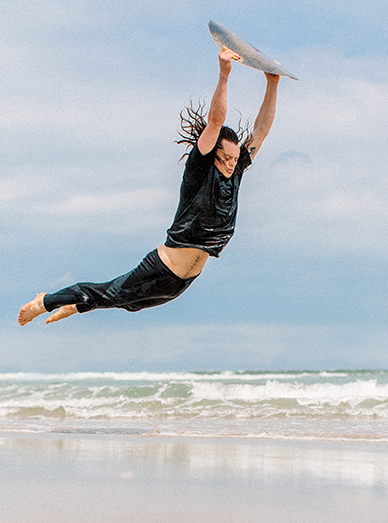
Hometown: Pittsburgh | Resides in: New York City| Majored in: Art and philosophy | Advanced degree: Master's in fine arts, School of the Art Institute of Chicago | Job title: Visual artist, dancer and co-founder/co-artistic director of Boomerang Dance and Performance Project
Matty Davis ’12 is a philosopher who works out his ideas about life, meaning and beauty through creating visual and movement-based art. A multimedia artist, he works in sculpture, print, photography, film and jewelry. But he’s gaining the most momentum and name recognition in the world of dance. Boomerang, which he co-founded in 2012 with Kenyon dance professor Kora Radella and classmate Adrian Galvin ’12, has performed internationally in theaters large and small — and even in Death Valley. A New York Times headline dubbed Boomerang “a dance project with fashion, literary and indie-rock cred” and a Chicago Tribune reviewer described Davis as “a buoyant, athletic, creative mover.”
Discovering dance: “I made an attempt each year that I was at Kenyon to try and do something that I hadn’t pursued before,” Davis said. This led him to try his first dance class — ever. The class was taught by Radella, and both teacher and student realized early on that Davis had a gift.
The philosophy of movement: Davis’ studies in philosophy have greatly informed his approach to creating art. “Philosophy has very much lingered with me, and one of my biggest long-standing influences has been phenomenologist Maurice Merleau-Ponty, whom I was introduced to by Professor Joel Richeimer, for his ideas concerning the way in which ‘the body is our general medium for having a world,’” Davis explained.
Dance as sport: “When I started dancing,” Davis said, “I saw this angle that I didn’t really feel was much represented in dance, based on how I had experienced the body in athletics and extreme sports: The body as subject to speed, force, collision, something that incurs damage and exhibits resilience, and which has a particular relationship to surfaces.”
The value of work: “You face a lot of rejection out there, and the only way you can keep going is to find something that feels wholly true and valuable to you, and to stick by that. Because that belief — in what your work can offer your life and life’s greater fabric — is really the motor for doing the work.”
Web extra: Watch a performance of Boomerang's "Repercussion," a work created in collaboration with Kora Radella, assistant professor of dance at Kenyon, Matty Davis, Adrian Galvin and Greg Saunier.
Find Matty Davis at: mattywdavis.com and boomerangdance.com | on Facebook: @boomerangdancekma | on Instagram:@boomerangdance | on Twitter: @boomerangdance
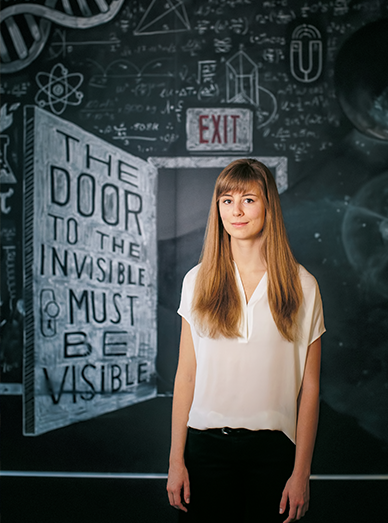
Hometown: Coeur d'Alene, Idaho | Resides in: Chicago | Majored in: Physics and Russian | Job title: Doctoral candidate in physics at the University of Chicago
As a doctoral student at the University of Chicago, Hillary Child ’13 is immersed in the field of computational cosmology, or, specifically, “using supercomputers to model the formation of large-scale structure in the universe.” In other words, she’s interested in better understanding how the stars and galaxies formed in their particular arrangements.
The possibilities of what she may one day discover through her research could actually be infinite."
Written in the stars: Child has been a science buff for as long as she can remember, but she credits her career path to her grandmother’s purchase of a “basic backyard telescope” that enabled a young Child to study the moon close-up, and dream of one day unlocking some of the mysteries of the sky.
A day in the life of a grad student: “I’m in my fourth year of grad school now. The first two years, at least for me, were a lot like undergrad, in that I went to classes and I went to different research group meetings. Now, I actually work at Argonne National Laboratory (a science and engineering research laboratory operated by the University of Chicago for the Department of Energy), in the suburbs of Chicago. I take a bus out there in the morning and then I spend most of the day at a computer, analyzing simulation data. I’ll calculate one thing and plot it, then that shows me something interesting or not quite expected, which suggests something else to plot. There’s also a lot of reading papers and talking with other people in the research group about our projects.”
Seeing halos: Child’s research so far has focused on measuring properties of halos in cosmological simulations. “Halos are blobs of invisible dark matter surrounding the galaxies we can see,” she explained. “By understanding how halos form and grow in simulations, we can learn about how the universe came to look the way it does today.
How she de-stresses: Child makes a habit of retreating to her university’s pool whenever she can for stress breaks. “I like to go swimming. I started that while at Kenyon because the pool was fantastic, and there is a very good pool here too,” she said. “The sensory deprivation and the sound of the water as you swim — I’m not good or fast or anything like that — but it’s very calming to just zone out and not think about anything for an hour except swimming.”
Advice for Kenyon students: “Start early and apply for everything you can, even if you don’t think you’ll get it. Because you might, and it’s great when you do.” Child took her own advice at Kenyon, applying for and winning a National Science Foundation Graduate Research Fellowship during her senior year. The fellowship provided a $34,000-a-year stipend for three years as well as $12,000 a year to her graduate institution for the cost of education.
In her own words: “I like the day-to-day work that I am doing. I like doing the data analysis. You start with equations and then the computer gives you huge sets of numbers, and you need to make sense of those in some way. Getting from the numbers to a picture that tells you something, I really enjoy that process.”
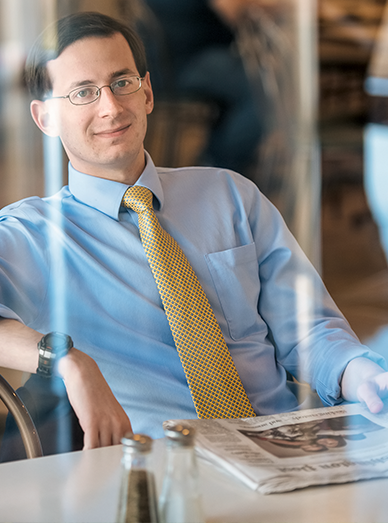
Hometown: Chevy Chase, Maryland | Resides in: Washington, D.C | Majored in: Political science | Job title: Cybersecurity reporter for Politico
Eric Geller ’14 never expected his writing for the Kenyon Collegian to lead to a career as a cybersecurity reporter, but since graduating, he has acquired expertise in one of the most important emerging issues of our time. As stories swirl about Distributed Denial of Service (DDoS) attacks, cyberwar and Russian hackers, Geller hopes cybersecurity reporters like him will one day have the cachet of journalists covering the White House or Capitol Hill. He’s well on his way: with more than 25,000 Twitter followers, Geller has been retweeted by political stars like MSNBC’s Chris Hayes and White House counselor Kellyanne Conway.
The malicious little toaster: According to Geller, a significant issue in cybersecurity is the ease of hacking into smart devices — household appliances connected to the so-called “internet of things.” “It is very easy right now to set up a device in your house that is connected to the internet, not think about security, and not change the default password,” Geller said. “There are various types of malicious software out there that essentially roam the internet looking for these devices, infect them and let somebody else take them over remotely. And if you’re a hacker and you take control of millions of webcams or thermostats, you can use those devices without their owners knowing to launch all kinds of attacks.”
The simplest way to protect your own cybersecurity: Geller recommends that everyone activate two-factor authentication (2FA) for email, social media and other online services that offer the safeguard. When 2FA is activated, users must enter an additional code, often received via text message, to verify their identity prior to logging in. “That’s a way for Facebook to make sure that you really are you,” Geller said. “If I steal your password and you don’t have 2FA turned on, I can log in from anywhere.”
Biggest interview, so far: At the Center for the Study of American Democracy (CSAD) conference, held in Gambier last spring, Geller interviewed FBI Director James Comey P’16. “It was great to be able to sit down with him even for just 10 or 15 minutes and try to understand where he was coming from, because obviously his importance in U.S. politics has only become more massive. I think a lot of people who write about cybersecurity never thought that he could have become more important than he was earlier last year, during the encryption fight (with Apple), and somehow he managed to become even more important to politics and government. To have had that opportunity to talk to him before all that happened is something that I won’t forget,” he said.
Advice for Kenyon students: “Go to all the CSAD events that you can, even if it’s a topic that isn’t core to your interests. The opportunity to hear from people from large cities and large think tanks and government agencies, the chance to hear from people in that broader government and political world outside of Gambier, on your home turf, is something that you should not pass up.”
Find Eric Geller on Twitter: @ericgeller
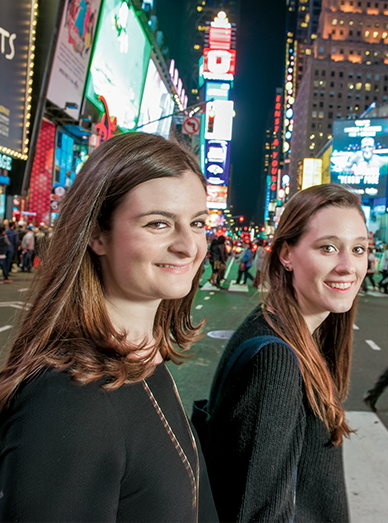
Hometowns: Miller is from Cleveland, Ohio; Greer is from Richmond, Virginia | Reside in: New York City | Majored in: Drama | Job title: Artistic directors of The Hearth, a theater production company, founded to “nurture and celebrate female-identifying artists” and “develop plays that represent the complex and vast spectrum of womanhood.”
It may be 2017, but the theater world remains plagued by a persistent gender gap. At Kenyon, Emma Miller ’15 and Julia Greer ’15 took notice of the relative lack of meaty roles available for women in theater and, in response, resurrected Stage Femmes, a female theater group that had been on hiatus since the early 2000s. Last year, the friends launched their own company, The Hearth, which is “committed to making room for the next generation of female artists in the landscape of the American theater.”
“We’ve created the New York version of Stage Femmes,” Greer said with a laugh.
“The Power of Punctuation”: In July 2016, before forming The Hearth, Miller and Greer produced the off-Broadway premiere of “The Power of Punctuation” by Natalie Margolin ’14 at the Davenport Theatre. The New York Times gave the play a glowing review and described it as “smart and well-acted ... a small, welcome oasis of entertainment.”
Leaping into action: After getting their feet wet in the New York theater scene, “We put our heads together and tried to understand what it might take to launch this company in New York,” Miller said. “We were able to have a more specific focus here because we practiced at Kenyon. At Kenyon, we saw that there weren’t a lot of roles for women. When there were, they weren’t that exciting. When we got to New York, we arrived with a real sense of what we wanted to do.”
Creating opportunities: “We are focused not only on producing work by women about women, but we’re working with women creators to make these stories into a reality — all from the perspective of the female experience,” Greer said. Miller added, “It is important to us that wherever there are jobs, those jobs are being done by women when they can be. And oftentimes, there’s no reason why they can’t be.”
We are focusing not only on having women write stories about women, but we're having other women design and make these stories into a reality."
Don’t quit your day job: To support themselves and their passion project, Miller and Greer work day jobs. Miller does administrative work for a Jewish nonprofit organization, HaZamir, and Greer works for Clif Bar and picks up freelance theater production jobs on the side.
Their 10-year plan: “We want The Hearth to feel like a home for a lot of people — like a space in the city that is safe and exciting,” Greer explained. “We want to produce and develop more shows and expand our reach.”
In their own words: “Something that has astounded me about being 23 is that it feels like my contemporaries are doing amazing things and really fast. I feel excited to be a part of a generation that is working really hard to do something about this insane time that we are (living) in,” Miller said.
Web extra: While at Kenyon, Greer and Miller were interviewed about Stage Femmes by Megan Wolpert Dobkin '95 in a video directed and produced by Mia Barnett '15.
Find them at: thehearththeater.com | on Facebook and Twitter: @thehearthco

Hometown: New York City | Resides in: New York City | Majored in: History | Job title: Private events chef at Blue Hill at Stone Barns in Pocantico Hills, New York
At age 8, Gracie Gardner ’16 took it upon herself to cook a gourmet dinner for her family for the first time: balsamic-glazed salmon with lemon parsley pasta. Since then, she has made it her mission to learn everything she can about the history, preparation and future of food. The most recent grad of this bunch, she was promoted from intern to line chef in the private events kitchen at famed Blue Hill at Stone Barns, the brainchild of award-winning chef and co-owner Dan Barber, whose book, “The Third Plate,” has positioned him as a thought leader in the fields of food and agricultural policy.
On food as gratitude: “For me, food was always the way that I could express gratitude to the people in my life. I remember the first time I got a significant amount of money — a $25 allowance. I was around 8 years old. I told my family that I wanted to take them out to a fancy dinner. I picked a restaurant that obviously cost so much more than $25. I ordered all of this stuff and honestly thought that it was on me — that I could pick up the tab. At the end of the meal, the manager brought out a check for $25 because my dad had asked him to bring out a separate check. And then my dad paid the rest.”
On studying history: “I already was so focused on food and knew that was what I wanted to go into (after college). Studying history allowed me to learn so much about the world, but in my actual papers I chose to write about the history of food very often. It gave me the space to keep exploring food in an academic setting.”
Fun fact: Gardner says often that she “majored in history with a minor in cooking for my friends.” She frequently baked sourdough bread for her friends, kept a pasta maker in her room and once lugged 30 jars of home-canned tomatoes back to college after summer vacation.
On cooking in the Blue Hill kitchen: “Every Thursday, we have a family meal with everyone involved in the restaurant and Stone Barns, and a speaker comes to talk about something new in the food world. Every day is a learning moment in terms of how we can best use our land, and what the land produces, in a way that is sustainable and also beautiful in the food that we create.”
Favorite meal near Kenyon: Early Birds Breakfast in St. Louisville, Ohio. “It’s just amazing. They have the best eggs, pancakes and French toast,” Gardner said.
In her own words: “I think it’s really important to be present in what’s happening in your life at the moment. It’s very apparent to me that now is the time for learning, and I just need to do everything that I can to put myself in situations to learn from people who really inspire me in this world.”
Find Gracie Gardner at: graciegardnermakes.wordpress.com
— Elizabeth Weinstein
Inspired by a call to "get proximate," students help lead a teach-in at the site of an infamous lynching.
Read The StoryA student-driven initiative aims for campus carbon neutrality within decades.
Read The Story